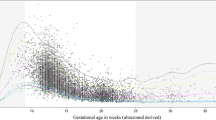Abstract
The purpose of this study was to compare early human chorionic gonadotropin secretion in two groups of pregnancies. These pregnancies were obtained, in one group, during a natural cycle, while, in the other group, they resulted from gamete intrafallopian transfers performed in hyperstimulated cycles. A logarithmic regression analysis was chosen to allow statistical comparison of serial plasmatic evaluation as hormone determinations were obtained, among patients, at different postovulatory days. The regression lines of the two groups of patients presented similar slopes. The unpairedt test performed on calculated data for 3 different days constantly revealed significantly higher levels (P<0.005) of natural vs stimulated cycles; thus a different origin on thex axis (days of the luteal phase) is deduced. These findings support the possibility of a delay in the appearance of human chorionic hormone in the patients undergoing gamete intrafallopian transfer technique.
Similar content being viewed by others
References
Englert Y, Roger M, Belaisch-Allart J, Jondet M, Frydman R, Testart J: Delayed appearance of plasmatic chorionic gonadotropin in pregnancies after in vitro fertilization and embryo transfer. Fertil Steril 1984;42:835–838
Asch RH, Ellsworth IR, Balmaceda JP, Wong PC: Pregnancy after translaparoscopic gamete intrafallopian transfer. Lancet 1984;2:1034–1035
Vermesh M, Kletzky OA, Davajan V, Israel R: Monitoring techniques to predict and detect ovulation. Fertil Steril 1987;47:259–264
Lenton EA, Neal LM, Sulaiman R: Plasma concentrations of human chorionic gonadotropin from the time of implantation until the second week of pregnancy. Fertil Steril 1982;37:773–778
Chartier M, Roger M, Barrat J, Michelson B: Measurement and plasma human chorionic gonadotropin (hCG) and beta-hCG activities in the late luteal phase: Evidence of the occurrence of spontaneous menstrual abortions in infertile women. Fertil Steril 1979;31:134–137
Testart J, Frydman R: Minimum time lapse between luteinizing hormone surge or human gonadotropin administration and follicular rupture. Fertil Steril 1982;37:50–53
Seegar Jones G: Luteal phase in a program for in vitro fertilization.in In Vitro Fertilization, HW Jones, G Seegar Jones, GD Hodgen, Z Rosenwaks (eds). Baltimore, Williams and Wilkins, 1986, pp 221–237
Camus M, Devroey P, Englert Y, Destree G, Braeckmans P, Khan I, Staessen C, Smitz J, Van den Abbeel E, Van Waesberghe L, Wisanto A, Van Steirteghem AC: Comparison between chorionic gonadotropin hormone profiles in pregnancies obtained after gamete intrafallopian transfer (GIFT), in vitro fertilization (IVF) or transfer of frozen-thawed embryos. 43rd Annual Meeting of the American Fertility Society, Reno, Nevada, p 110 (abstr)
Author information
Authors and Affiliations
Rights and permissions
About this article
Cite this article
Remorgida, V., Anserini, P., Costa, M. et al. Gamete intrafallopian transfer and plasma chorionic gonadotropin dynamics: Evidence of a delayed appearance. J Assist Reprod Genet 5, 195–198 (1988). https://doi.org/10.1007/BF01131121
Received:
Accepted:
Issue Date:
DOI: https://doi.org/10.1007/BF01131121




